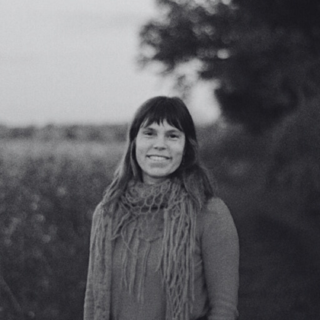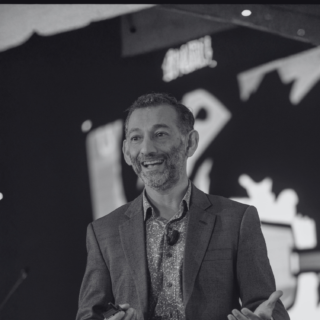Chapter 1: A New Golden Era
04 Mar
Reboot the Future was founded following the success of Imaginal Cells: Visions of Transformation - a thought-provoking anthology that explores how a compassionate approach to business, politics and the environment would make the planet a better place for us to live.
The book, an exclusive selection of essays from 25 the world’s greatest thought-leaders, suggests that we could radically transform the world by allowing the Golden Rule to shift our thinking and behaviour.
In the following chapter, the book's co-authors Kim Polman and Steven Vasconcellos introduce this preliminary concept and its symbolic link to, of all things, the butterfly.
Humankind is facing challenges that raise questions over our continued stewardship of the planet.
Our generation has the potentially calamitous honour of witnessing the birth of a new era, the Anthropocene. It is an era defined by our irreversible impacts on the world, by changes to the climate, worsening threats to eco-systems, rapid rise in extinction rates and burgeoning levels of pollution.
A radical shift is needed for the longevity of the human race. We are at a turning point. But what principle could help propel this urgently needed change?
For over 3,000 years, one altruistic maxim has been the bedrock of humanity, underlying our most successful religions and cultures. It has been cited through the ages by prophets, religious leaders and philosophers as the guiding principle of human interaction.

The Golden Rule
Throughout history humankind has been urged to lead lives based around this simple principle. The earliest recorded mention was made by the ancient Egyptians in 1800 BC. Later, Buddha in India, Confucius in China and the Greek philosophers all wrote versions of the rule around 500 BC. Jesus established all his teachings on this basic idea: the importance of Love. Loving one's neighbour, loving your enemies.
In 610 AD, Muhammad included in the Qur'an, "Woe to those who cheat: they demand a fair measure from others but they do not give it themselves." (83:1-3). Several Hadiths clarify this: "None of you is a true believer unless he wishes for his brother what he wishes for himself."
Around in the following centuries leaders professed this truth: Shintoism in 700 AD in Japan, The Book of Kell in Ireland in 810, the Inca leader Manco Capac in Peru in 1200, The Tales of Sendebar in India in 1200, Sikhism in India in 1400, and many more.
Intriguingly, neuroscientists have taken this a step further, proving we become happier ourselves when we act to help others because our brains exude satisfying dopamine and oxytocin.
However, in the modern world our tolerance has been challenged as the bonds within our own communities have stretched while individual and regional leaders encouraged observance, it was always local.
Now, through modern technologies, we have a rare ability to create a worldwide movement. The potential for good is enormous. If enough of us subscribe to living compassionately and more sensitively toward others and other forms of life, then we can make a difference.
As the author Dov Siedman explains in his essay, we start a personal level, then continue at a group level, then reach further still to a global level. Finally, the world starts to change for the better.
In our book Imaginal Cells: Visions of Transformation, the celebrated Johan Rockstrom scientifically sets out the scale of the threats the Earth faces. A changing atmosphere, species loss and dwindling bio-capacity are among nine significant planetary boundaries he describes. He describes the Earth "as moving out of its Garden of Eden" state to a new, precarious and unpredictable phase.
There is little guarantee we can avoid this fate. However, the United Nation's Sustainable Development Goals and the Paris Climate Agreement, both signed within weeks of each other in 2015, give a guide to what needs to be achieved. Both agreements are a historic oppertunity to create not just a better world, but a remarkable one.
Yet, the process requires resetting our intentions and redesigning our interactions with vision purpose and also speed. The leading figures grouped together in this journal share the believe that this mission, along with a new sense of global compassion engendered by The Golden Rule can street the way to a better planet.
It requires a worldwide transformation at times so fundamental that it is difficult to imagine. However, there is a parallel. Most of us know about the incredible metamorphosis of a caterpillar into a butterfly.

The scientific processes that underpin its change as instructive. After a period of ravenous consumption, the caterpillar forms a chrysalis from which it will dissolve itself into an organic strew, where dormant "Imaginal Cells" hold the vision of a the new structure.
At first these Imaginal Cells operate independently as single cell organisms and are attached by the caterpillars immune system which views them as a threat.
But soon these new cells regroup, multiply, and connect with each other. They then form clusters and begin resonating at the same frequency. Finally, they reach a tipping point and consolidate to become a new multi-cell organism - the beautiful butterfly.
Today, humanity is at its own tipping point, we face overlapping challenges so great that failure to navigate any one of those challenges (let alone a combination) could threaten our species' survival, as well as other life on Earth.
This is the driving force behind this project: for the vision and ideas put forward by the amazing contributors to this journal to serve as our very own Imaginal Cells.
Our simple project of bringing them together aims to conceive a chrysalis that holds a unified vision of transformation, founded on a simple global principle.
Each essay, or Imaginal Cell, offers a key to transforming an aspect of our small, troubled world and to realising something almost unimaginably beautiful.
At this collective heart, these essays also have the same DNA, a call to treat others as you would like to be treated.
Kim Polman & Stephen Vasconcellos-Sharpe
Co-authors of Imaginal Cells: Visions of Transformation.


